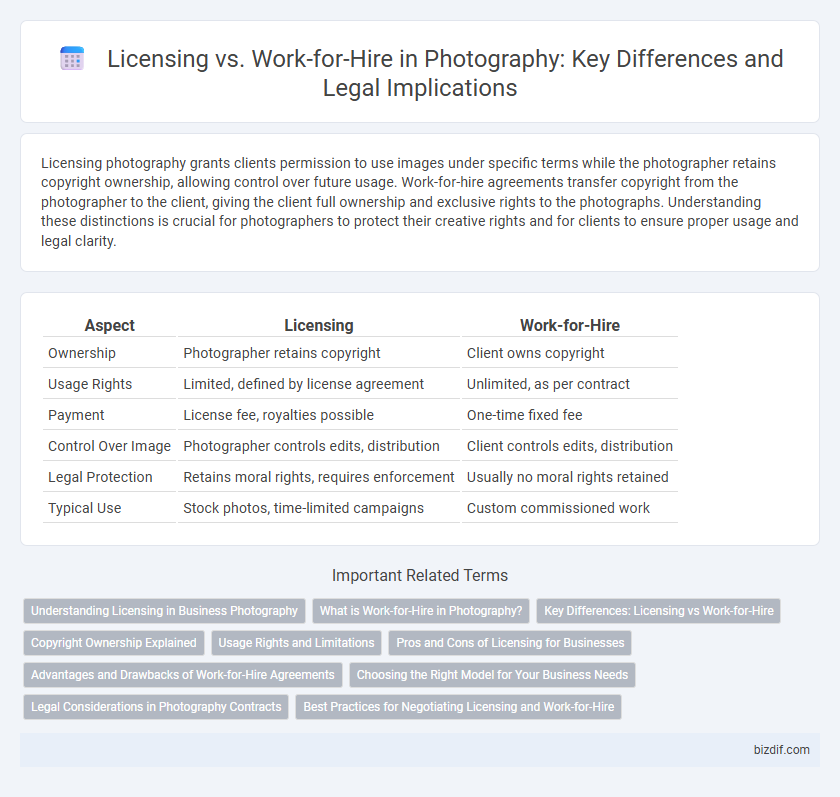Licensing photography grants clients permission to use images under specific terms while the photographer retains copyright ownership, allowing control over future usage. Work-for-hire agreements transfer copyright from the photographer to the client, giving the client full ownership and exclusive rights to the photographs. Understanding these distinctions is crucial for photographers to protect their creative rights and for clients to ensure proper usage and legal clarity.
Table of Comparison
| Aspect | Licensing | Work-for-Hire |
|---|---|---|
| Ownership | Photographer retains copyright | Client owns copyright |
| Usage Rights | Limited, defined by license agreement | Unlimited, as per contract |
| Payment | License fee, royalties possible | One-time fixed fee |
| Control Over Image | Photographer controls edits, distribution | Client controls edits, distribution |
| Legal Protection | Retains moral rights, requires enforcement | Usually no moral rights retained |
| Typical Use | Stock photos, time-limited campaigns | Custom commissioned work |
Understanding Licensing in Business Photography
Licensing in business photography grants clients specific rights to use images under defined conditions, retaining the photographer's ownership and control over the work. It allows for flexible usage terms such as duration, geographic scope, and media platforms, which can maximize revenue through multiple licensing agreements. Clear licensing contracts protect both parties by outlining permitted uses and limitations, reducing legal risks and fostering professional relationships.
What is Work-for-Hire in Photography?
Work-for-hire in photography refers to an agreement where the photographer's images are created as commissioned work, making the client the legal copyright owner from the moment of creation. Unlike licensing, which grants usage rights while the photographer retains copyright, work-for-hire transfers all ownership permanently without ongoing royalties. This arrangement is common in commercial photography, such as advertising campaigns or corporate projects, ensuring clients have full control over images for unlimited use.
Key Differences: Licensing vs Work-for-Hire
Licensing grants photographers limited rights to use their images while retaining ownership, allowing clients to utilize photos under specific terms and conditions. Work-for-hire transfers full ownership of the photographs to the client upon creation, with the photographer relinquishing all rights. Understanding these distinctions ensures proper control over image usage, copyright ownership, and revenue opportunities.
Copyright Ownership Explained
Licensing in photography grants clients permission to use images under specific terms while the photographer retains copyright ownership, allowing control over reproduction and distribution. Work-for-hire agreements transfer copyright ownership entirely to the client, meaning the photographer relinquishes all rights and the client becomes the legal copyright owner. Understanding the distinctions is crucial for photographers to protect their intellectual property and negotiate usage rights effectively.
Usage Rights and Limitations
Licensing in photography grants clients specific usage rights while the photographer retains copyright, allowing for controlled use such as limited reproduction or distribution. Work-for-hire agreements transfer full ownership and copyright to the client, eliminating usage restrictions and giving clients complete control over how the images are used. Understanding these distinctions is crucial for photographers to define boundaries on image use, reproduction, and licensing fees.
Pros and Cons of Licensing for Businesses
Licensing photography allows businesses to use high-quality images without transferring ownership, providing flexibility and cost-effectiveness by paying for specific usage rights. However, licensing can lead to limitations in image customization and potential ongoing fees if extended rights are needed. Opting for licensing over work-for-hire reduces upfront expenses and risks while maintaining control over how and where the images are used.
Advantages and Drawbacks of Work-for-Hire Agreements
Work-for-hire agreements grant clients full ownership of photography work upon creation, ensuring complete control and use without ongoing fees or permissions. Photographers may lose all rights to their images, limiting portfolio use and future revenue from licensing or resale. While providing clear legal certainty for clients, these agreements often offer lower initial compensation compared to licensing arrangements that allow photographers to retain copyright.
Choosing the Right Model for Your Business Needs
Licensing allows photographers to retain ownership of their images while granting clients specific usage rights, making it ideal for ongoing revenue and brand control. Work-for-hire agreements transfer full ownership to the client, providing immediate, clear-cut rights but limiting future earnings from the work. Selecting the appropriate model depends on your business goals, whether prioritizing long-term royalties through licensing or immediate payments with work-for-hire contracts.
Legal Considerations in Photography Contracts
Photographers must carefully evaluate licensing agreements versus work-for-hire contracts to determine ownership and usage rights of images. Licensing allows photographers to retain copyright while granting clients specific usage permissions, whereas work-for-hire typically transfers full copyright ownership to the client upon project completion. Clear contract language is essential to avoid disputes regarding image reproduction, distribution, and intellectual property rights in professional photography.
Best Practices for Negotiating Licensing and Work-for-Hire
Negotiating licensing agreements requires clear definition of usage rights, duration, and territories to protect the photographer's intellectual property and ensure fair compensation. In work-for-hire contracts, specifying deliverables, ownership transfer, and scope of work helps prevent disputes and guarantees that the client obtains full rights as agreed. Employing standardized contracts and consulting with legal experts optimize clarity and safeguard both parties' interests in photography projects.
Licensing vs Work-for-Hire Infographic

 bizdif.com
bizdif.com